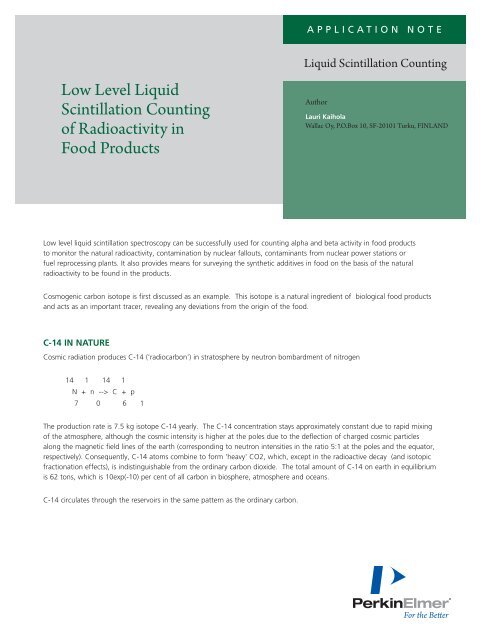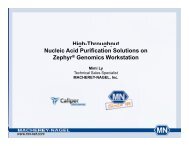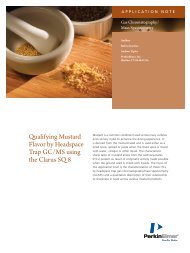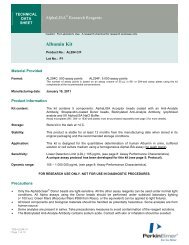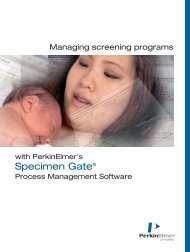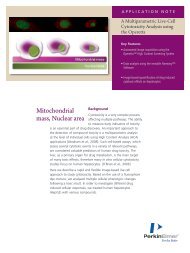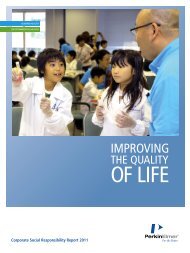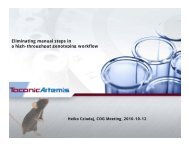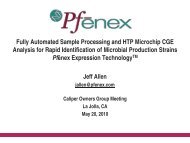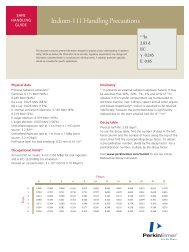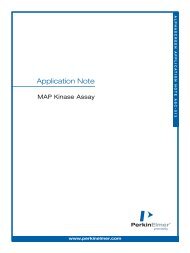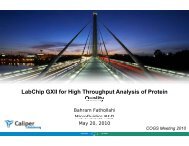Low Level Liquid Scintillation Counting of Radioactivity - PerkinElmer
Low Level Liquid Scintillation Counting of Radioactivity - PerkinElmer
Low Level Liquid Scintillation Counting of Radioactivity - PerkinElmer
You also want an ePaper? Increase the reach of your titles
YUMPU automatically turns print PDFs into web optimized ePapers that Google loves.
application Note<br />
<strong>Liquid</strong> <strong>Scintillation</strong> <strong>Counting</strong><br />
<strong>Low</strong> <strong>Level</strong> <strong>Liquid</strong><br />
<strong>Scintillation</strong> <strong>Counting</strong><br />
<strong>of</strong> <strong>Radioactivity</strong> in<br />
Food Products<br />
Author<br />
Lauri Kaihola<br />
Wallac Oy, P.O.Box 10, SF-20101 Turku, FINLAND<br />
<strong>Low</strong> level liquid scintillation spectroscopy can be successfully used for counting alpha and beta activity in food products<br />
to monitor the natural radioactivity, contamination by nuclear fallouts, contaminants from nuclear power stations or<br />
fuel reprocessing plants. It also provides means for surveying the synthetic additives in food on the basis <strong>of</strong> the natural<br />
radioactivity to be found in the products.<br />
Cosmogenic carbon isotope is first discussed as an example. This isotope is a natural ingredient <strong>of</strong> biological food products<br />
and acts as an important tracer, revealing any deviations from the origin <strong>of</strong> the food.<br />
C-14 IN NATURE<br />
Cosmic radiation produces C-14 ('radiocarbon') in stratosphere by neutron bombardment <strong>of</strong> nitrogen<br />
14 1 14 1<br />
N + n --> C + p<br />
7 0 6 1<br />
The production rate is 7.5 kg isotope C-14 yearly. The C-14 concentration stays approximately constant due to rapid mixing<br />
<strong>of</strong> the atmosphere, although the cosmic intensity is higher at the poles due to the deflection <strong>of</strong> charged cosmic particles<br />
along the magnetic field lines <strong>of</strong> the earth (corresponding to neutron intensities in the ratio 5:1 at the poles and the equator,<br />
respectively). Consequently, C-14 atoms combine to form 'heavy' CO2, which, except in the radioactive decay (and isotopic<br />
fractionation effects), is indistinguishable from the ordinary carbon dioxide. The total amount <strong>of</strong> C-14 on earth in equilibrium<br />
is 62 tons, which is 10exp(-10) per cent <strong>of</strong> all carbon in biosphere, atmosphere and oceans.<br />
C-14 circulates through the reservoirs in the same pattern as the ordinary carbon.
Decay <strong>of</strong> C-14 is through beta emission, where simultaneously emitted neutrino takes part <strong>of</strong> the decay energy<br />
and therefore beta particle is not monoenergetic but has a long tailed energy spectrum with maximum energy<br />
150 keV and the mean energy 30 keV:<br />
14 14 -<br />
C --> N + b + y<br />
6 7<br />
Half life in the above decay is 5730 +- 40 a.<br />
PRINCIPLE OF C-14 DATING<br />
All the living matter becomes marked with C-14, which decays exponentially after the death <strong>of</strong> the object. One<br />
is then able to calculate the age t <strong>of</strong> the object by taking a sample and comparing its present activity C with the<br />
activity at its death Co<br />
5730 Co<br />
t = ----- ln (-----).<br />
ln2 C<br />
Obviously one has to make the assumption that the C-14 concentration in the exchange reservoir has been<br />
constant or is known at the time <strong>of</strong> death <strong>of</strong> the object.<br />
This principle <strong>of</strong> radiocarbon dating was proposed by W.F. Libby in 1946 and he was conferred a Nobel prize in<br />
chemistry for it in 1960. The same principle has then been applied using other cosmogenic isotopes as tracers<br />
(K-Ar dating etc.).<br />
MAN-MADE FLUCTUATIONS IN C-14 CONCENTRATION<br />
The constancy <strong>of</strong> the C-14 content is quite a reasonable assumption to make and from measurements on known<br />
age samples it appears that within a few percent the assumption is valid back to 1500 B.C. There have been<br />
fluctuations caused by climate as well as short and long term variations due to the sunspot activity and changes<br />
<strong>of</strong> the geomagnetic moment. There are, however, also man-made fluctuations in the C-14 content:<br />
1) 'Fossil effect' or the Suess effect<br />
The combustion <strong>of</strong> coal and oil releases into the atmosphere large quantities <strong>of</strong> CO2 in which the C14 has<br />
decayed long ago. This 'dead' carbon dilutes the C-14 concentration in the air. Therefore, the activity <strong>of</strong> wood<br />
samples, grown say in 1950 (prior to hydrogen bomb testing) is in fact lower than in samples grown in 1850<br />
prior to the industrial revolution despite the decay that has occurred in the latter.<br />
2) Effect <strong>of</strong> nuclear weapon tests<br />
It has been estimated that neutrons released in fission and fusion explosions until 1962 have caused the<br />
formation <strong>of</strong> about 2 tons <strong>of</strong> C-14. If this were distributed uniformly, there would be an excess <strong>of</strong> 3 % <strong>of</strong> C-14.<br />
However, there is a 'hold-up' in the atmosphere and so the effect is much greater and the concentration was<br />
twice the prebomb one in 1963 (see fig. 2) and has since decreased to 30 % excess. (The bomb effect has<br />
been useful in studying the carbon cycle because <strong>of</strong> the prohibition <strong>of</strong> the atmospheric and ocean tests in 1963<br />
by an agreement between the superpowers.)<br />
2
COUNTING OF C-14 BY LOW LEVEL LIQUID SCINTILLATION SPECTROMETRY<br />
In most cases for radiocarbon dating the organic samples are converted into benzene (C6H6) for liquid<br />
scintillation counting by first combusting into CO2, which is further, synthesized into lithium carbide with lithium<br />
above 750C<br />
2CO 2<br />
+ 10Li ---> Li2C 2<br />
+ 4Li 2<br />
O.<br />
This is then hydrolized into acetylene in reaction<br />
Li2C 2<br />
+ 2H 2<br />
O ---> C 2<br />
H 2<br />
+ 2 LiOH.<br />
Acetylene is converted in the presence<br />
<strong>of</strong> a catalyst into benzene.<br />
<strong>Counting</strong> <strong>of</strong> C-14 activity is accomplished by adding scintillation agent, e.g. butyl-PBD in the benzene sample.<br />
LIQUID SCINTILLATION COUNTING OF FOOD<br />
A) Disclosing adulteration <strong>of</strong> food<br />
There are legislative requirements that synthetic food or alcohol can not be distributed for use. In most cases<br />
standard chemical methods are satisfactory to monitor unauthorized use <strong>of</strong> synthetic substituents. In some other<br />
cases they are not identifying synthetic materials <strong>of</strong> identical composition. Synthetic food may be made out <strong>of</strong><br />
petroleum derived raw material having minimal content <strong>of</strong> C-14 activity. In those cases it is possible to enforce<br />
the law by analysing food for the content <strong>of</strong> C-14 (the same principle can be used for dating <strong>of</strong> wines). Normal<br />
C-14 activity for fresh food will be around 18 dpm/g carbon (= modern carbon). <strong>Low</strong>er activities decline due to<br />
dilution by synthetic raw materials.<br />
<strong>Counting</strong> can be accomplished on CO2 produced by combustion and dissolved in the scintillation liquid or<br />
by synthesizing the food into benzene like in radiocarbon dating. The former method does not allow large<br />
concentrations <strong>of</strong> carbon to be introduced in the cocktail and the latter one means quite elaborate synthesis.<br />
Another way is to ferment the product, starch, sugar; etc. into alcohol with can be counted directly in a cocktail.<br />
Measurement <strong>of</strong> the C-14 content <strong>of</strong> ethanol (or gasohol in some countries, which must originate from<br />
renewable sources, i.e. contains only 'modern' carbon) can be done directly mixing with the scintillation liquid.<br />
The mixing ratios may be up to 3:2 in ethanol:scintillation liquid ratio. It is advantageous to use alcohol with less<br />
than 10 % water in it.<br />
<strong>Low</strong>er limit <strong>of</strong> detection in Quantulus is 0.1 dpm/g carbon for 100 min counting time and 3 sigma resolution<br />
criterion (Schönh<strong>of</strong>er). This means that less than a 1 per cent dilution <strong>of</strong> 'modern' alcohol by synthetic one is<br />
revealed at 99.5 % probability in 100 min counting.<br />
Direct counting <strong>of</strong> caffeine and cinnamic aldehyde has been carried out by Noakes and H<strong>of</strong>fman to evaluate the<br />
presence and degree <strong>of</strong> adulteration.<br />
B) <strong>Counting</strong> <strong>of</strong> radioactive contamination <strong>of</strong> food<br />
Recent nuclear fallout has clearly shown the need to be able to monitor the radioactivity <strong>of</strong> food by reasonably<br />
fast methods. In most instances gamma spectrometry is the appropriate method to apply. The semiconductor<br />
detectors have excellent energy resolution enabling efficient identification <strong>of</strong> the <strong>of</strong>ten numerous low activity<br />
isotopes. <strong>Low</strong> level liquid scintillation spectrometry has its areas <strong>of</strong> application as is seen in the following<br />
examples.<br />
3
Cs-137<br />
Cs-137 can be monitored on the basis <strong>of</strong> its 662 keV gamma emission, which is actually from the metastable<br />
daughter Ba-137m. Actually Cs-137 first decays by beta emission, with 82 % probability through 500 keV beta<br />
emission into Ba-137m and with 8 % probability directly to Ba-137. Beta emission can be very well measured by<br />
liquid scintillation spectrometry. Identification <strong>of</strong> this isotope is further determined by the monoenergetic conversion<br />
electron peak at 625 keV.<br />
Sr-90/Y-90<br />
These isotopes have only beta decay mode and therefore liquid scintillation method is a very suitable one to use.<br />
Alpha counting<br />
Pulse shape analysis provides a means for alpha/beta separation on the basis <strong>of</strong> their different pulse lengths (shapes).<br />
Fluorescent decay <strong>of</strong> scintillation light is composed <strong>of</strong> prompt and delayed components; most <strong>of</strong> the light is<br />
produced in the prompt component. The amount <strong>of</strong> the light in the delayed component has long been known<br />
to be dependent on the particle or decay type: electrons originating from beta decay, gamma and X-rays are the<br />
predominant sources <strong>of</strong> prompt fluorescence, whereas alpha decay contributes more to the delayed component<br />
giving longer pulses than those produced by electrons. Beta particles are about ten times more effective in producing<br />
light than alpha particles. This is why the beta spectrum covers the alpha spectrum range in a scintillation counter<br />
although alpha particle energies are higher, typically 4 to 9 MeV.<br />
The Pulse Shape Analyser works by producing a PSA value, which relates the pulse length to the pulse amplitude.<br />
Thus the amplitude dependence <strong>of</strong> the pulse length is minimized. <strong>Counting</strong> <strong>of</strong> radon in water is a good example <strong>of</strong><br />
the application <strong>of</strong> the pulse shape analyser. Direct mixing <strong>of</strong> the sample is also in this case a sufficient method <strong>of</strong><br />
sample preparation.<br />
Rn-222 is a daughter <strong>of</strong> radium-226 in the uranium decay series. In Finland the bedrock is radioactive to some extent<br />
to introduce alpha activity in waters from drilled wells. (Problematic is radon from soil in some areas penetrating into<br />
houses and representing the major radioactive load.)<br />
The alpha spectrum <strong>of</strong> Rn-222 shows four peaks, Rn-222 and Po-214 intermixed and Po-218 very well separated at<br />
a higher energy. In the equilibrium we then have three times <strong>of</strong> the alpha activity <strong>of</strong> radon present in the sample.<br />
Radium and its predecessors do not very much dissolve in water to be seen in the spectrum. The beta emissions in<br />
the series are by Pb-214 and Bi-214 and by the next isotope in the series after Po-214 is Pb-210 with 22 a half-life,<br />
thus being <strong>of</strong> low activity.<br />
Very low backgrounds are achieved in alpha counting, typically 0.05 cpm in teflon counting vial and 0.3 in glass vials.<br />
At Am-241 alpha energy (5.5 MeV) these values lead to LLD = 0.1 and 0.3 mBq/sample. When one measures higher<br />
alpha energies like Po-214 (7.6 MeV), the background is even less, 0.005 cpm in a teflon vial and LLD = 0.03 mBq.<br />
4
REFERENCES<br />
Baxter, M.S. and Walton, A., Carbon-14 Concentrations in Recent Wines and Spirits. J. Food Sci. 36, 540 (1971).<br />
Resmini, P., Volonterio, G. and Cecchi, L., Detection <strong>of</strong> the synthetic labelled (C-14) ethanol added to wines and other<br />
alcoholic products (in Italian). Rivista di Viticoltura ed Enologia di Conegliano, N. 8, Agosto 1976, Instituto di Industrie<br />
Agrarie Dell'Universita' di Milano.<br />
Kaneko, T., Ohmori, S. and Masai, H., An Improved Method for the Discrimination between Biogenic and Synthetic<br />
Acetic Acid with a <strong>Liquid</strong> <strong>Scintillation</strong> Counter. J. Food Sci., 38, 350 (1973).<br />
Osina, P., Berk, H. and Moghissi, A.A., Determination <strong>of</strong> the origin and age <strong>of</strong> alcoholic beverages by liquid scintillation<br />
counting. In <strong>Liquid</strong> <strong>Scintillation</strong> <strong>Counting</strong>, Recent Applications and Development Vol. II, Sample Preparation and<br />
Applications, ed. Chin-Tzu Peng, Donald L. Horrocks, Edward L. Alpen,<br />
Academic Press, New York, 1980, p. 469.<br />
Kostadinov, K.N. and Yanev, Y.L., <strong>Liquid</strong> <strong>Scintillation</strong> Measurement <strong>of</strong> C-14 in Ethanol Extracted from Bulgarian Wines.<br />
Nucl. Instr. Methods in Phys. Res. B17, 511 (1986).<br />
Schönh<strong>of</strong>er, F. and Weisz, J., Measurement by Ultra <strong>Low</strong> <strong>Level</strong> <strong>Liquid</strong> <strong>Scintillation</strong> <strong>Counting</strong> Following the Chernobyl<br />
Accident. J. Radioanal. Nucl. Chem. 115 (1), 125 (1987).<br />
Schönh<strong>of</strong>er, F. and Henrich, E., Recent Progress and Application <strong>of</strong> <strong>Low</strong> <strong>Level</strong> <strong>Liquid</strong> <strong>Scintillation</strong> <strong>Counting</strong>. J. Radioanal.<br />
Nucl. Chem. 115 (2), 317 (1987).<br />
Schönh<strong>of</strong>er F., C-14 in Austrian Wine and Vinegar. Radiocarbon 34(3), 768-771 (1992).<br />
Noakes, J.E. and H<strong>of</strong>fman, P.G., Determination <strong>of</strong> natural product purity by radiocarbon measurement. In <strong>Liquid</strong><br />
<strong>Scintillation</strong> <strong>Counting</strong>, Recent Applications and Development Vol. II, Sample Preparation and Applications, ed. Chin-Tzu<br />
Peng, Donald L. Horrocks, Edward L. Alpen, Academic Press, New York, 1980, p. 457.<br />
Noakes, J.E., Applications <strong>of</strong> <strong>Low</strong>-<strong>Level</strong> <strong>Liquid</strong> <strong>Scintillation</strong> <strong>Counting</strong>, in Advances in <strong>Scintillation</strong> <strong>Counting</strong>, eds.<br />
S.A.McQuarrie, C. Ediss and L.I. Wiebe, University <strong>of</strong> Alberta, Edmonton, 1983, p. 407.<br />
Salonen, L., Determination <strong>of</strong> Sr-90 and Sr-89 in environmental samples by liquid scintillation counting. In <strong>Liquid</strong><br />
<strong>Scintillation</strong> <strong>Counting</strong>, Vol. 5., 15-31, 1978.<br />
Salonen, L. and Kaihola, L., <strong>Low</strong>-<strong>Level</strong> <strong>Liquid</strong> <strong>Scintillation</strong> <strong>Counting</strong> <strong>of</strong> Sr-89 and Sr-90. 1988.<br />
Juznic, K. and Fedina, S., Radiochemical determination <strong>of</strong> Sr-90 and Sr-89 in soil. Fresenius Z. Anal. Chem. 323, 261<br />
(1986).<br />
Suomela, J., F”renklad metod f”r analys av strontium-90 i mjölk (A simplified method for Sr-90 analysis in milk). SSIrapport<br />
87-22. Swedish Radiation Protection Institute, 1987, 7 pp.<br />
Melin, J. and Suomela, J., Rapid determination <strong>of</strong> Sr-89 and Sr-90 in food and environmental samples by Cerenkov<br />
counting. 2nd Research and Coordination Meeting <strong>of</strong> Coordinated Research Programme on Rapid Instrumentation And<br />
Separation Methods For Monitoring Radionuclides In Food And Environmental Samples. IAEA, Vienna, 12-16 August,<br />
1991. 9 pp.<br />
5
Buzinny, M.G., Zelensky, A.V. and Los', I.P., Beta-Spectrometric Determination <strong>of</strong> Sr-90 in Water, Milk and Other Samples<br />
with Ultra-<strong>Low</strong>-<strong>Level</strong> <strong>Liquid</strong> <strong>Scintillation</strong> Counter. In <strong>Liquid</strong> <strong>Scintillation</strong> Spectrometry 1992, Proc. <strong>of</strong> the Int. Conf. on Advances<br />
in LSC, LSC 92, Vienna, Austria, Sept 14-18, 1992. Eds. J.E. Noakes, F. Schönh<strong>of</strong>er and H.A. Polach. Radiocarbon, Tucson<br />
1993., pp. 439-446.<br />
Bjornstad, H.E., Lien, H.N., Yu-Fu, Y. and Salbu, B., Determination <strong>of</strong> Sr-90 in environmental and biological materials with<br />
combined HDEHP solvent extraction - low level liquid scintillation counting technique. J. Radioanal. Nucl. Chem., Letters 156<br />
(5), 165-173 (1992).<br />
Suschny, O., Determination <strong>of</strong> Environmental <strong>Radioactivity</strong> at Two Different Concentration <strong>Level</strong>s. Results <strong>of</strong> Two Recent IAEA<br />
Inter-Comparisons. Nucl.Instr.Meth.Phys.Res. 223, 477 (1984).<br />
Lopes, J.S., Pinto, R.E., Almendra, M.E. and Machado, J.A., Variation <strong>of</strong> C-14 Activity <strong>of</strong> Portugese Wines from 1940 to 1974.<br />
In Proc. Int. Conf. on <strong>Low</strong>-Activity Measurements and Applications, 6-10 Oct 1975, Bratislava, 1977 p. 261.<br />
Asikainen, M., Natural <strong>Radioactivity</strong> <strong>of</strong> Ground Water and Drinking Water in Finland. Ph.D. Thesis. STL-A39. Institute <strong>of</strong><br />
Radiation Protection, Helsinki, Finland, 1982.<br />
Salonen, L. and Hukkanen, H., Advantages <strong>of</strong> low-background liquid scintillation alpha-spectrometry and pulse shape analysis<br />
in measuring Rn-222, uranium and Ra-226 in groundwater samples. J. Radional. Nucl. Chem. 226 (1-2), 67-74 (1997).<br />
Muck, K., Sinojmeri, M. and Steger, F., Long-term Availability <strong>of</strong> Sr-90 in Foodstuff after Nuclear Fallout. P-11-246 in<br />
http://www.irpa.net/pub/pr/index.html<br />
<strong>PerkinElmer</strong>, Inc.<br />
940 Winter Street<br />
Waltham, MA 02451 USA<br />
P: (800) 762-4000 or<br />
(+1) 203-925-4602<br />
www.perkinelmer.com<br />
For a complete listing <strong>of</strong> our global <strong>of</strong>fices, visit www.perkinelmer.com/ContactUs<br />
Copyright ©2011, <strong>PerkinElmer</strong>, Inc. All rights reserved. <strong>PerkinElmer</strong> ® is a registered trademark <strong>of</strong> <strong>PerkinElmer</strong>, Inc. All other trademarks are the property <strong>of</strong> their respective owners.<br />
009647_01 Printed in USA


